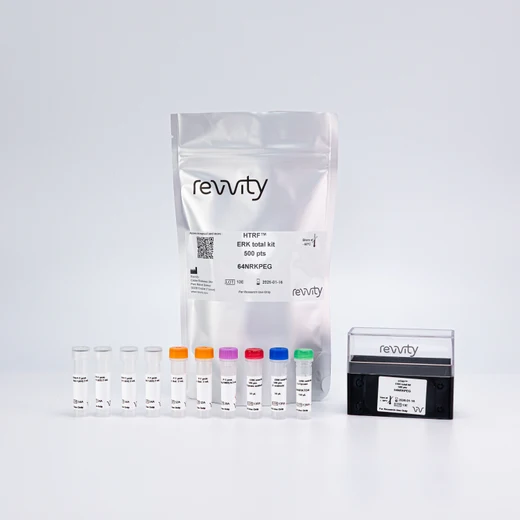

HTRF Human and Mouse Total ERK Detection Kit, 96 Assay Points






This HTRF kit monitors the cellular ERK expression level and can be used as a normalization assay for the phospho-ERK kit.
For research use only. Not for use in diagnostic procedures. All products to be used in accordance with applicable laws and regulations including without limitation, consumption & disposal requirements under European REACH regulations (EC 1907/2006).
Product information
Overview
The Total-ERK1/2 assay is ideal for ERK normalization with the phospho-ERK kits. It is compatible with the buffers from the phospho or Advanced phospho-ERK kits, so the same lysate can be used for fast and easy analysis of the total and the phosphorylated protein populations.
Specifications
| Assay Points |
96
|
|---|---|
| Assay Target Type |
Kit
|
| Assay Technology |
HTRF
|
| Brand |
HTRF
|
| Quantity |
1
|
| Therapeutic Area |
Metabolism/Diabetes
NASH/Fibrosis
Neuroscience
Oncology & Inflammation
Rare Diseases
|
| Unit Size |
96 Assay Points
|
Video gallery


How it works
Total-ERK assay principle
The Total-ERK assay quantifies the expression level of ERK in a cell lysate. Contrary to Western Blot, the assay is entirely plate-based and does not require gels, electrophoresis or transfer. The Total-ERK assay uses two labeled antibodies: one coupled to a donor fluorophore, the other to an acceptor. Both antibodies are highly specific for a distinct epitope on the protein. In presence of ERK in a cell extract, the addition of these conjugates brings the donor fluorophore into close proximity with the acceptor and thereby generates a FRET signal. Its intensity is directly proportional to the concentration of the protein present in the sample, and provides a means of assessing the proteins expression under a no-wash assay format.

Total-ERK 2-plate assay protocol
The 2 plate protocol involves culturing cells in a 96-well plate before lysis then transferring lysates to a 384-well low volume detection plate before adding Total ERK HTRF detection reagents. This protocol enables the cells' viability and confluence to be monitored.

Total-ERK 1-plate assay protocol
Detection of total ERK with HTRF reagents can be performed in a single plate used for culturing, stimulation and lysis. No washing steps are required. This HTS designed protocol enables miniaturization while maintaining robust HTRF quality.

Assay validation
Validation of total-ERK1/2 assay on various cell lines
Human (Hela, A431, HEK293, Jurkat), murine (NIH 3T3) and Hamster (CHO-K1) cells were grown in a T175 flask at 37°C, 5% CO2 for 2 days. After removal of cell culture medium, 3 mL of supplemented lysis buffer 3 were added and incubated for 45 min. Soluble supernatants were collected after 10 min centrifuging. ERK1/2 was detected using 16 µL of cell lysate. Cell lines from other species have not been tested, hence they must be evaluated case by case.

Total-ERK assay to control phosphorylation of ERK1/2
A431 cells (100,000 cells/well) were activated with EGF for 10 min, using the two-plate assay protocol of the Phospho-ERK1/2 and Total-ERK1/2 assays. As expected, results obtained show a dose-response increase of ERK1/2 phosphorylation upon EGF stimulation while ERK1/2 expression level remains constant.

Simplified pathway
MAPK/ERK cell signaling
The MAPK/ERK signaling cascade is activated by a wide variety of receptors involved in growth and differentiation. The core signal transduction cascade elicits regulation of numerous cellular processes including adhesion, migration, apoptosis, differentiation and metabolism. MEK1/2 catalyze the phosphorylation of ERK1/2 at Tyr204 and Thr202. In response, ERK phosphorylates hundreds of cytoplasmic and nuclear substrates. The wide complexity and diversity of MAPK signaling makes ERK a key regulator and major signaling node in biology.

ERK in GPCR signaling
ERK modulation plays a major role in GPCR signaling and is therefore an important measurable GPCR readout. GPCRs act via G proteins to regulate a wide range of cellular functions. Upon stimulation, these receptors activate effectors like adenylate cyclase and phospholipase C, which influence not only intracellular concentrations of second messengers like cAMP and Ca2+, but also mediate ERK1/2 phosphorylation. GPCRs have also been shown to mediate ERK1/2 activation in a G protein-independent but beta-arrestin dependent manner.

SDS, COAs, Manuals and more
Are you looking for technical documents for this product. We have housed them in a dedicated section., click on the links below to explore.


How can we help you?
We are here to answer your questions.






























